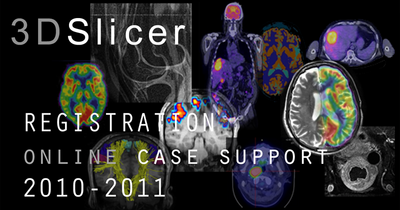Registration:Resampling
Contents
Resampling in 3D Slicer
| Several distinct tools are available within 3D Slicer for resampling image data to change orientation, resolution or field of view. The organization below is intended to help you choose the best module for your task Note that there are also many related functions that change aspects of the image without requiring a resampling, e.g. changing the aspect ratio or slice view orientation. They are listed in a separate category below. |
Consider adding your case to the library: If your resampling task is related to a registration problem, we can (for 2010-2011) offer you direct consulting: If we can add your (anonymized) case to the Library, we will assist you with registering/resampling by processing your case and providing step-by-step instructions and best-practice tips. See here for details. |
What we mean by Resampling
Resampling builds a new dataset (image, surface, fiducials etc.) from an existing one, but with a different orientation, resolution, field of view or aspect ratio. For example the last step in registering two images consists of two main steps: finding the transform and resampling according to this transform. So the last step in registration will be to resample the moving data according to a spatial transform function, and thereby generate a new and aligned image. Or changing the voxel size to something larger or smaller involves resampling.
See Wikipedia for a more detailed definition.
Interpolation is the process of estimating the value of the data based on surrounding values. This is necessary because spatial realignment is unlikely to be in exact multiples of voxel sizes. Please pay attention to selecting the proper interpolation method for your data-type. For more detail on interpolation we recommend this Wikipedia article.
Resampling in Place: Change Resolution or Field of View
- The crop volume module...
- The Resample Scalar Volume Module changes resolution (spacing) of an image, allowing several interpolation options for different data types. This is the method of choice if you wish to increase or decrease the number of voxels per mm or make the voxel size isotropic. You need to specify the desired voxel size in mm. If you do not know the current voxel size of your image, go to the Info tab in the Volumes module.
- The Resample Scalar Volume Batch Make module is the batch version of the above Resample Scalar Volume module. Use this if you have many image files that need to have their resolution changed/adjusted. The new resampled images will be written back out to a specified directory.
Resampling via a spatial transform
- The Resample ResampleScalarVectorDWIVolume Module sends both scalar and vector images through a transform. Several interpolation options.
- The Harden Transforms function (context menu via the right mouse button) in the Data Module can also be used to resample an image or fiducial set through a linear transform.
Resampling Vector- and Tensor-Data
- The Resample ResampleScalarVectorDWIVolume Module is the method of choice to realign vector or tensor data, such as DTI along a given transform. It supports both linear and nonlinear transforms as well as deformation fields. Note that simply sending each component of the vector or tensor through the transform separately would yield an incorrect result. This module will transform the vector/tensor data correctly.
- The Resample DTI Volume module is designed specifically for moving diffusion tensor MRI data. It supports both linear and nonlinear transforms as well as deformation fields. Note that simply sending each component of the DTI tensor through the transform separately would yield an incorrect result. This module will transform the vector/tensor data correctly.
Resampling Surface- and Model-Data
- The Model Transform Module reorients your surface model based on a transform. It creates a new model which is a transformed version of the input polygonal model
